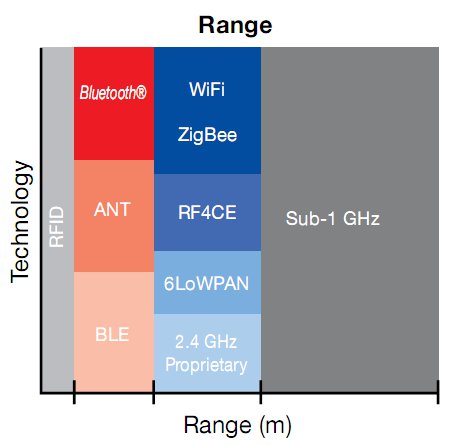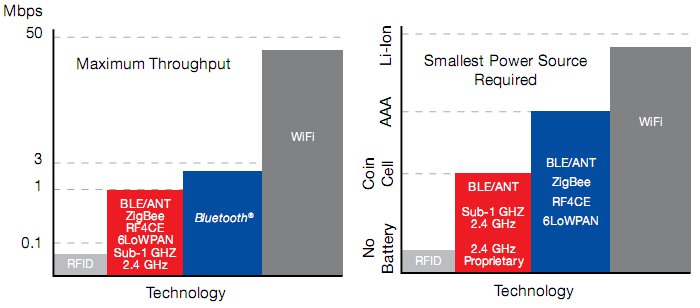While designing your embedded system, you may have to choose between different wireless standards to match your needs. I’ll provide a list a short and mid-range wireless standards, their description and links to open source software stacks (when available) to help you better understand the different options available. Wide Area Network wireless network such as LTE, Wimax, etc.. won’t be discussed in this blog entry.

Mesh and IP Networks:
- Wifi (IEEE 802.11): Wifi is probably the most used wireless standard in consumer electronics devices today as it allows users to connect their device to their LAN wirelessly. An access point has a typical range of about 20 meters indoors and up to 100m outdoors. There are 4 standards 802.11a 802.11b, 802.11g and 802.11n. The latest has a theoretical throughput of 300 Mbps. Check out Wikipedia Wifi page for details. The Wi-Fi stack is part of the Linux kernel but you still need specific drivers for a given hardware that may or may not be part of the kernel.
- Zigbee (IEEE 802.15.4-2006): Zigbee is a low-cost, low-power wireless mesh network standard. It can have a range up to 10-meter with a transfer rate of 250 kbit/s. It is mainly used in applications such as home automation and smart grid. Check out Wikipedia Zigbee page for details. An open source Zigbee stack (alpha phase) is available at http://sourceforge.net/projects/linux-zigbee/ and some devices driver are already part of the kernel e.g. XBee USB Adapter.
- 6LoWPAN: 6LoWPAN stands for “IPv6 over Low power Wireless Personal Area Networks” and IPv6 packets are sent over IEEE 802.15.4 based networks. The open standard (RFC4944) is available at http://tools.ietf.org/html/rfc4944. 6LoWPAN is used for devices that need wireless internet connectivity at lower data rates such as automation and entertainment applications in home, meters of the smart grid etc… You may also visit Wikipedia 6LoWPAN page for further details. On the software side, you may want to check http://code.google.com/p/lnx-6lowpan/ and http://www.sics.se/contiki/contiki-6lowpan-uipv6-faq.html.
- ONE-NET: ONE-NET is an open-source standard for wireless networkingdesigned for low-cost, low-power control networks for applications such as home automation, security & monitoring, device control and sensor networks. Please read ONE-NET Wireless Control Network Presentation to learn about the standard, its cost effectiveness and the hardware platforms available. You can also download the source code of ONE-NET protocol stack (the latest version is ONE-NET Code v.1.6.2 released in February 2011) and read the documentation. Evaluation modules can be purchased from M2 Innovations for about 60 USD.
Personal Area Networks (WPAN):
- Bluetooth V4.0: Bluetooth is a proprietary secure open wireless technology standard for exchanging data over short distances (using short wavelength radio transmissions in the ISM band from 2400-2480 MHz) from fixed and mobile devices with a maximum throughput of 24 MBit/s. It is widely used in mobile phones for point to point communication between devices. See Wikipedia Bluetooth page for details. BlueZ is the official Bluetooth stack for Linux. One example of chip supporting Bluetooth is Texas Instruments CC2560.
- Bluetooth Low Energy (Wibree): Bluetooth low energy is a subset to Bluetooth V4.0 with an entirely new protocol stack for rapid build-up of simple links. The data rate is much slower (~200 kbit/s), but the setup time is much faster (<3ms vs. <6s for Bluetooth 2.1). This is mainly used for sensors that may have to run a year or more one a button cell battery. Check out Wikipedia Bluetooth Low Energy (BLE) for details on this standard. BlueZ protocol stack also supports this subset of the Bluetooth 4.0 standard, although this may have to be perfected as this is relatively new. TI’s CC2540 System-on-Chip supports BLE and a software stack (BLEStack) is provided.
- Zigbee RF4CE: ZigBee RF4CE is basically an IR (InfraRed) replacement where radio control applications can operate non-line-of-sight and provide more advanced features based on bi-directional communication. This is used in remote controls, input devices and for 3D synchronization. Please read the white paper “Understanding Zigbee RF4CE” for details. I could not find an open source stack, but chip vendor such as Texas Instruments will provide a stack for their chip. In the case of TI, Zigbee RF4CE protocol stack is implemented in their Zigbee Stack called TIMAC.
- Wireless USB (WUSB): Wireless USB is a short-range, high-bandwidth wireless radio communication protocol. It can send and receive data at 480 Mbit/s at distances up to 3 meters and 110 Mbit/s at up to 10 meters. Wireless USB is used in game controllers, printers, scanners, digital cameras, MP3 players, hard disks and flash drives. Check out Wikipedia Wireless USB page for details.
- ANT: ANT is a proprietary wireless sensor network technology operating at 2.4 GHz that provides a low-cost and ultra-low power solution for short-range wireless communication in point-to-point and more complex network topologies. ANT technology is used for collection, automatic transfer and tracking of sensor data within sports, wellness management and home health monitoring applications. Check out the official ANT page for details on the protocol and developers may checkout the Developer’s Zone for software downloads and reference platforms.

Parts of this blog entry has been taken from Texas Instruments’ Low Power RF Products and Solutions pdf, you may refer to this document if you are looking for wireless chipsets.

Jean-Luc started CNX Software in 2010 as a part-time endeavor, before quitting his job as a software engineering manager, and starting to write daily news, and reviews full time later in 2011.
Support CNX Software! Donate via cryptocurrencies, become a Patron on Patreon, or purchase goods on Amazon or Aliexpress




